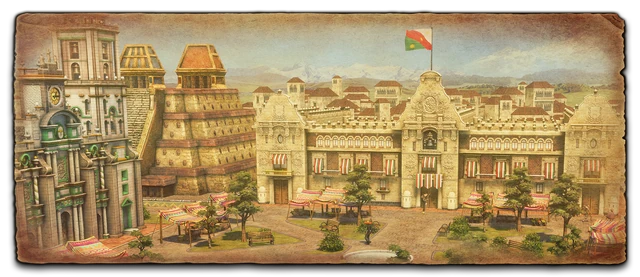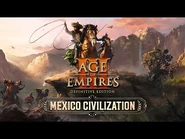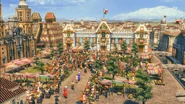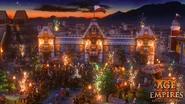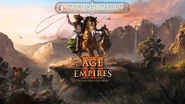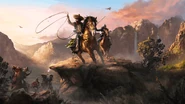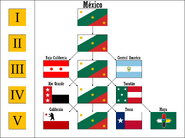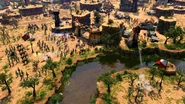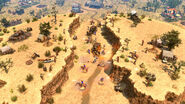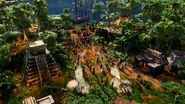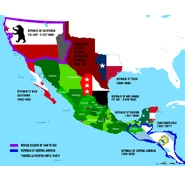| This article is about the civilization. For other uses, see Mexico. |
| “ | Born out of a fiery insurgency against Spanish colonial rule, the young Mexican nation asserted itself and triumphed despite numerous revolutions and invasions. | ” |
| —Release announcement post | ||
The Mexicans are a Federal American civilization introduced as DLC to Age of Empires III: Definitive Edition.
Announced on November 22, 2021[1] for Steam and the Microsoft Store, it was released on December 1 of the same year.
Home City[]
- Default General names
- First names
- Agustín, Anastasio, Antonio, Carlos, Felipe, Francisco, Hermenegildo, Ignacio, Jean, Jose, José, Juan, Leonardo, Manuel, Mariano, Melchor, Miguel, Nicolás, Vicente, Victor
- Middle names (optional)
- Antonio el Amo, Arteaga, Gómez, Ignacio, Joaquín, López, Pablo, Salazar, Santiago
- Last names
- Allende, Anaya, Arago, Arista, Barragán, Bravo, Bustamante, Escobedo, Galeana, Gutierrez, Herrera, Iturbide, Javier Mina, Magallanes, Moctezuma, Múzquiz, Rayón, Rosales, Ruiz, Santa Anna, Torres, Victoria, Xicoténcatl, de Allende, de Arago, de Galeana, de Gutierrez, de Magallanes, de Moctezuma, de Rosales, de Torres
- Default Padre names
- First names
- Antonio, Bartolomé, Francisco, Jesús, José, Juan, Keith, Luis, Mariano, Miguel, Salvador, Vicente
- Middle names (optional)
- Diego, Felipe, López, Méndez
- Last names
- Alfaro Velásquez, Antonio Torres, Arricivita, Bautista, Cuauhtlatoatzin, González Lafón, Hidalgo, Matamoros, Morelos, Neri de Alfaro, Ruiz de Esparza y Dávalos, de Santa María, de Yermo Parres, de las Casas, de los Ángeles
 Soldiers Marching - Soldiers of Mexico marching through the town (5 points)
Soldiers Marching - Soldiers of Mexico marching through the town (5 points) Plaza del Zócalo (original) - The original version of the Plaza del Zócalo (Default)
Plaza del Zócalo (original) - The original version of the Plaza del Zócalo (Default) Plaza del Zócalo (alternative) - The alternative version of the Plaza del Zócalo (2 points)
Plaza del Zócalo (alternative) - The alternative version of the Plaza del Zócalo (2 points) Day of the Dead (Día de Muertos) 1/2 - The citizens of Mexico celebrating Day of the Dead by wearing skull masks (5 points)
Day of the Dead (Día de Muertos) 1/2 - The citizens of Mexico celebrating Day of the Dead by wearing skull masks (5 points) Day of the Dead (Día de Muertos) 2/2 - The citizens of Mexico celebrating Day of the Dead by lighting fireworks (10 points; requires Day of the Dead (Día de Muertos) 1/2)
Day of the Dead (Día de Muertos) 2/2 - The citizens of Mexico celebrating Day of the Dead by lighting fireworks (10 points; requires Day of the Dead (Día de Muertos) 1/2)
 Day Lighitng - The city with the sun shining brightly (Default)
Day Lighitng - The city with the sun shining brightly (Default) Night Lighting - The city at night (15 points; requires Temple (original))
Night Lighting - The city at night (15 points; requires Temple (original)) Sunset Lighting - The city with the sun setting (5 points)
Sunset Lighting - The city with the sun setting (5 points) National Palace (original) - The original version of the National Palace (Default)
National Palace (original) - The original version of the National Palace (Default) National Palace (alternative) - The alternative version of the National Palace (2 points)
National Palace (alternative) - The alternative version of the National Palace (2 points) Temple (Ruin) - The ruined version of the Temple (Default)
Temple (Ruin) - The ruined version of the Temple (Default) Temple (original) - The original version of the Temple (2 points)
Temple (original) - The original version of the Temple (2 points) Temple (red) - The red version of the Temple (2 points; requires Temple (original))
Temple (red) - The red version of the Temple (2 points; requires Temple (original))
 Metropolitan Cathedral (original) - The original version of the Metropolitan Cathedral (Default)
Metropolitan Cathedral (original) - The original version of the Metropolitan Cathedral (Default) Metropolitan Cathedral (alternative) - The alternative version of the Metropolitan Cathedral (2 points)
Metropolitan Cathedral (alternative) - The alternative version of the Metropolitan Cathedral (2 points) Metropolitan Cathedral (sandstone) - The sandstone version of the Metropolitan Cathedral (2 points)
Metropolitan Cathedral (sandstone) - The sandstone version of the Metropolitan Cathedral (2 points) Metropolitan Cathedral (light blue) - The light blue version of the Metropolitan Cathedral (2 points)
Metropolitan Cathedral (light blue) - The light blue version of the Metropolitan Cathedral (2 points) Metropolitan Cathedral (white) - The white version of the Metropolitan Cathedral (2 points)
Metropolitan Cathedral (white) - The white version of the Metropolitan Cathedral (2 points)
Characteristics[]
Civilization bonuses[]
- Starts with 400 food, 200 wood, 100 coin, six Settlers, and a Cow
- Settlers have a lower train limit (85)
- Receives the Padre in the Commerce Age, who acts as a unique Priest that can pacify enemies
- Choose Federal States to advance in Age and add new Home City Cards to the Deck, starting with fewer cards (21) than other civilizations
- Can revolt in the Commerce, Fortress and Industrial Ages, and (for some revolutionary nations) revert into Mexico
- National Guard units: Salteador (Vigilante), Chinaco (Charro)
[]
 General: The hero of the civilization. Explores, fights, builds Forts and Trading Posts. Cannot die. If he falls unconscious, he can be rescued.
General: The hero of the civilization. Explores, fights, builds Forts and Trading Posts. Cannot die. If he falls unconscious, he can be rescued. Sloop: Small and nimble warship. Good at exploring, fishing or transport.
Sloop: Small and nimble warship. Good at exploring, fishing or transport. Steamer: Powerful, steam-propelled warship resistant to building fire that can train units, construct docks and gather fish.
Steamer: Powerful, steam-propelled warship resistant to building fire that can train units, construct docks and gather fish. Ironclad: Advanced armored warship.
Ironclad: Advanced armored warship.
Unique units[]
 Padre: Heroic Mexican Priest. Explores, fights, builds Cathedrals and Trading Posts. Cannot die. If he falls unconscious, he can be rescued.
Padre: Heroic Mexican Priest. Explores, fights, builds Cathedrals and Trading Posts. Cannot die. If he falls unconscious, he can be rescued. Insurgente: An insurgent peasant armed with whatever they could find. Good against cavalry and buildings.
Insurgente: An insurgent peasant armed with whatever they could find. Good against cavalry and buildings. Soldado: Very sturdy, but slow training, Heavy Infantry armed with a musket and grenades.
Soldado: Very sturdy, but slow training, Heavy Infantry armed with a musket and grenades. Salteador: Stealthy Skirmisher that can see the location of enemies they've recently damaged.
Salteador: Stealthy Skirmisher that can see the location of enemies they've recently damaged. Chinaco: Heavy cavalry armed with a lance for extra range. Good against skirmishers, and holds its own against cavalry.
Chinaco: Heavy cavalry armed with a lance for extra range. Good against skirmishers, and holds its own against cavalry. Desperado: A dangerous outlaw with two pistols. Can attack with both pistols at the same time.
Desperado: A dangerous outlaw with two pistols. Can attack with both pistols at the same time. Cuatrero: A dangerous outlaw on horseback. Ranged Cavalry with a Lasso ability.
Cuatrero: A dangerous outlaw on horseback. Ranged Cavalry with a Lasso ability. Bandido: A dangerous outlaw with a rifle. Throws dynamite to damage infantry or buildings.
Bandido: A dangerous outlaw with a rifle. Throws dynamite to damage infantry or buildings.
Revolutionary units[]
 Filibuster: Freewheeling heavy infantry on an unauthorized military expedition. Constructs buildings or destroys them with dynamite.
Filibuster: Freewheeling heavy infantry on an unauthorized military expedition. Constructs buildings or destroys them with dynamite.
Revolting to Baja California turns Settlers into Filibusters. Californio: Ranged Cavalry with a Lasso ability. Good against cavalry.
Californio: Ranged Cavalry with a Lasso ability. Good against cavalry.
Revolting to California turns Settlers into Californios. Cruzob Avenger: Cruzob Skirmisher. Salteador with extra speed, range, and LOS. Revolting to Maya turns Salteadores into Cruzob Avengers.
Cruzob Avenger: Cruzob Skirmisher. Salteador with extra speed, range, and LOS. Revolting to Maya turns Salteadores into Cruzob Avengers. Cruzob Infantry: Cruzob Musketeer that counters cavalry from range.
Cruzob Infantry: Cruzob Musketeer that counters cavalry from range.
Revolting to Maya turns Soldados into Cruzob Infantry. Revolutionary: Solid general-purpose infantry. Good against cavalry.
Revolutionary: Solid general-purpose infantry. Good against cavalry.
Revolting to Rio Grande turns Settlers into Revolutionaries; Revolting to Central America or Yucatán keep the Settlers, but Town Centers will produce Revolutionaries instead; Central America Revolutionaries have 25% less health and damage. State Militia: Skirmisher with low range that sacrifices attack for hitpoints. Gains additional hitpoints in groups.
State Militia: Skirmisher with low range that sacrifices attack for hitpoints. Gains additional hitpoints in groups.
Revolting to Texas turns Settlers into Volunteers and allows them to be trained in place of Settlers and Insurgentes. Yucateco Insurgente: Veteran Insurgente with 10% more attack and a Lasso ability. Revolting to Yucatan turns Insurgentes into Yucateco Insurgentes. Revolting to Yucatán keeps the Settlers, but they can become Yucateco Insurgentes with the card Plan de Mérida.
Yucateco Insurgente: Veteran Insurgente with 10% more attack and a Lasso ability. Revolting to Yucatan turns Insurgentes into Yucateco Insurgentes. Revolting to Yucatán keeps the Settlers, but they can become Yucateco Insurgentes with the card Plan de Mérida.
[]
 Saloon: Trains sinister outlaws and mercenaries.
Saloon: Trains sinister outlaws and mercenaries.
Unique buildings[]
 Cathedral: Mexican Church building that can revive a fallen Padre, protects nearby buildings, and has powerful unique upgrades.
Cathedral: Mexican Church building that can revive a fallen Padre, protects nearby buildings, and has powerful unique upgrades. Hacienda: Economic building that combines Estate, Mill, and Livestock Pen.
Hacienda: Economic building that combines Estate, Mill, and Livestock Pen.
Federal States[]
- Chiapas, Durango, Michoacán, Querétaro, Tlaxcala (Commerce Age)
- Coahuila, San Luis Potosí, Sinaloa, Sonora, Tabasco (Fortress Age)
- Chihuahua, Guanajuato, Guerrero, Tamaulipas, Zacatecas (Industrial Age)
- Estado de México, Jalisco, Oaxaca, Puebla, Veracruz (Imperial Age)
Revolutions[]
 Baja California or
Baja California or  Central America (Commerce Age)
Central America (Commerce Age) Rio Grande or
Rio Grande or  Yucatán (Fortress Age)
Yucatán (Fortress Age) California or
California or  Texas (Industrial Age)
Texas (Industrial Age) Maya (Yucatán Revolution)
Maya (Yucatán Revolution)
Overview[]
In Age of Empires III: Definitive Edition, the burgeoning Mexican States can choose to Revolt instead of advancing to the Fortress, Industrial, or Imperial Ages. Each Revolt offers players a whole new deck full of opportunities. Unlike any other civilization, Mexico can reverse their revolts and return to Mexico, while still retaining access the benefits of any cards sent during the revolution. Add in a brand-new set of Federal States to evolve the gameplay and the Mexico civilization can adapt to any strategic situation like no other.
Campaign appearances[]
| This section needs expansion. You can help by adding to it. |
- Historical Battles
- Grito de Dolores
- Northern Revolutionary Army - Player
- Southern Revolutionary Army - Ally
- Mexican Towns - Ally
- Grito de Dolores
In-game dialogue[]
- Main article: Mexicans' dialogue lines
Mexican units all speak Mexican Spanish, with the exception of some units acquired via Home City Cards.
Common[]
- Select
- ¿A dónde nos dirigimos? - Where are we going to?
- ¿A dónde vamos? - Where are we going?
- ¿Almirante? - Admiral?
- Alisten pistolas - Prepare the pistols
- ¡Atención! - Attention!
- ¿Comandante? - Commander?
- ¿Cuál es la orden? - What is the order?
- ¿Cuáles son mis blancos? - Which are my targets?
- Estoy listo - I'm ready
- Hola - Hello
- Listo - Ready
- Listo para la batalla - Ready for battle
- Listo para la emboscada, comandante - Ready to ambush, commander
- Listo para pelear - Ready to fight
- Listos - Ready
- Listos para disparar - Ready to fire
- ¿Mande? - Order?
- Mande, presidente - Order, president
- ¿Me vas a pagar? - Are you going to pay me?
- ¿Órdenes? - Orders?
- ¿Qué hace falta? - What is required?
- ¿Qué tenemos que destruir? - What do we have to destroy?
- ¿Quién busca salvación? - Who is looking for salvation?
- Saludar, ya - Salute, now
- ¿Sí? - Yes?
- ¿Sí, mi comandante? - Yes, my commander?
- ¿Y yo qué saco? - (Mexican slang for: So, what am I going to earn?)
- Move
- A la batalla - To battle
- A la marcha - To the march!
- A zarpar - To sail
- Adelante - Forward
- Amén - Amen
- Ándale - Go
- Así será - So shall it be
- Avancen - Advance
- ¿Dónde está mi pago? - Where is my payment?
- En el nombre del padre - In the name of the Father
- En camino - On the way
- Entendido - Understood
- Entendido, mi comandante - Understood, my commander
- Estará listísimo - It will be (very) ready
- Estoy en camino - I'm on the way
- Ligero como el viento - Light as the wind
- Listos - Ready
- Marcha, ya - March, now!
- Me voy - I'm going
- No nos atraparán - They will not catch us
- No se lo van a esperar - They won't see it comming
- Nos espera el oro - The gold awaits us
- Que así sea - So be it
- Sí - Yes
- Vamos a desgraciarlos - (Mexican slang for: We are going to make a mess of them!)
- Vamos, señores - Come on, gentlemen!
- Vayámonos - Let's go!
- Vayamos - Let's go!
- ¡Viva México! - Long live Mexico!
- Attack
- ¡A la carga! - To charge!
- ¡A la batalla! - To battle!
- ¡Abajo con los opresores! - Down with the oppressors!
- ¡Abajo los opresores! - Down with the oppressors!
- ¡Ataca! - Attack!
- ¡Fuego! - Fire!
- ¡Los voy a fusilar! - I'm going to shoot them!
- ¡Me gusta pa' (para) morirme! - I like it, to die!
- ¡Mueran los invasores! - Death to the invaders
- ¡Por la gloria! - For the glory!
- ¡Por la libertad! - For freedom!
- ¡Por la patria! - For the motherland
- ¡Por México! - For Mexico!
- ¡Por nuestra libertad! - For our freedom!
- ¡Vamos a desgraciarlos! - (Mexican slang for: We are going to make a mess of them!)
- Prende la mecha - Light the fuse
- ¡Saquemos la chamba! - (Mexican slang for: Let's do the work!)
- ¡Saquen a los invasores! - Take out the invaders!
- ¡Sin problema! - No problem
Settlers[]
- Female Build Constructora - Builder (feminine)
- Male Build Constructor - Builder (masculine)
- Female Farm Granjera - Farmer (feminine)
- Male Farm Granjero - Farmer (masculine)
- Female Gather Coin Minera - Miner (feminine)
- Male Gather Coin Minero - Miner (masculine)
- Female Gather Fruit Recolectora - Gatherer (feminine)
- Male Gather Fruit Recolector - Gatherer (masculine)
- Female Gather Meat Cazadora - Huntress
- Male Gather Meat Cazador - Hunter
- Female Gather Wood Leñadora - Woodcutter (feminine)
- Male Gather Wood Leñador - Woodcutter (masculine)
General[]
No "Claim" line.
- Disabled ¿Mande? - Order?
- Ransomed Gracias por pagar mi rescate - Thank you for paying ransom for me
- Revived Se necesitará más que eso para mantenerme abajo - It will take more than that to keep me down
Padre[]
- Disabled Aunque yo muera, seré recordado para siempre - Even if I die, I will be remembered forever
- Revived 1 Los ángeles me han regresado a la vida - The angels have brought me back to life
- Revived 2 Nuestra señora de Guadalupe nos protege con sus manos milagrosas - Our lady of Guadalupe protects us with her miraculous hands
History[]
| “ | Like the United States, the history of Mexico begins millennia ago with the indigenous peoples who migrated to the North American continent and settled throughout, creating culturally and linguistically distinct societies. The majority of these were founded on hunter-gatherer subsistence, but some also practiced agriculture and engaged in activities such as metallurgy, nautical navigation, and long-distance trade. Notable examples include the Olmec, Maya, Toltec, and Aztec civilizations, famous for their rich material culture imprint and the impressive stone structures that they erected – sites still frequented by modern tourists. By the 15th century, Europe was undergoing a process of social and economic revolutions marked by, among other things, massive population booms and vibrant trade economies. An allure for luxury resources brought on by the taste that they had through trade partners in the Middle East spurred a desire to explore and establish settlements so as to have direct access to these resources. After Christopher Columbus stumbled upon the Caribbean islands while seeking an alternative western route to East Asia, European settlers began to flock to the so-called "New World" seeking land, wealth, and religious freedom, among other things. The lands comprising the modern Mexican nation were principally frequented by Spanish expeditionary soldiers, explorers, and settlers. These "conquistadors" subjugated the formidable Aztec Empire and various other indigenous inhabitants relatively quickly with their superior weaponry and diseases such as smallpox which decimated the local populations. Exploitative mercantile economies sprouted up in "New Spain", thriving on mines and encomienda plantation systems, and funneled wealth back to their mother nation for nearly three centuries. By the early 19th century, European colonial powers were gradually losing their grip over their possessions in the Western Hemisphere. As Enlightenment ideals electrified minds irrespective of class divisions, the inhabitants of the United States successfully revolted against their British overlords, setting an example that many of their neighbors were keen to follow. Dissatisfied with centuries of Spanish occupation, New Spain was ripe for such a movement, and the Napoleonic (French) invasion of Spain presented a terrific opportunity. In 1810, decisive steps were taken towards independence when the priest Miguel Hidalgo and Ignacio Allende, a former military officer, rallied mobs of disgruntled peasants and commoners into a loosely-knit army and began ousting the Spanish royalist occupants of several towns on the route to Mexico City. Despite a string of successes, Hidalgo enigmatically refused to attack Mexico City, eschewing his momentum and affording the royalists precious time to react. Shortly thereafter, his disorganized army was crushed and he and Allende were executed – but the spirit of independence that his uprising had stoked would not be quelled so easily. The movement continued under Ignacio López Rayón, José María Morelos, and Mariano Matamoros, who experienced considerably more (and prolonged) successes against the royalists owing mainly to organizational improvements. Despite some infighting which would see Rayón deposed and Morelos catapulted to primacy in the revolutionary Mexican state, the cause continued to progress. While it did experience further setbacks – Matamoros and Morelos would be captured and executed by royalist forces – resistance to Spanish rule continued for several years. In 1821, Augustín de Iturbide and Vicente Guerrero negotiated the Plan of Iguala, an alliance between their factions which all but cemented Mexican independence; an official proclamation would be made later that same year. Spain would unsuccessfully attempt to reconquer her former colony in 1829, but eventually conceded its independence in 1836. During this time, the fledgling nation struggled to establish a robust government and retain control of its vast territory; several of the southeastern regions in Central America seceded nearly immediately, and further problems arose when American settlers in modern-day Texas declared their independence in 1835 and upset the numerically superior Mexican army. After Texas joined the United States in 1845, another catastrophic war erupted and the Mexican forces were defeated, losing California and much of what would become the western USA in the process. In 1855, another revolt overthrew President Antonio López de Santa Anna, causing his conservative supporters to appeal to the French for aid in the conflict. The French briefly invaded and installed Maximilian Habsburg, but American intervention led the French to abandon the conservatives, allowing the liberal revolutionaries to emerge victorious. After several more years of infighting, Porfirio Díaz, known for his role in the renowned Battle of Puebla (1862), assumed control of the Mexican state and launched a series of reform programs, ushering the nation into the modern era. | ” |
Trivia[]
- The Mexican in-game flag is based on the flag of the Army of the Three Guarantees, which can be considered the first flag of Mexico as an independent country.
- This is because the current Mexican flag is protected under the Law on the National Arms, Flag, and Anthem, and can only be reproduced for official government purposes.[2]
- It is possible to see another design for the Mexican in-game flag in the trailer preview, where the eagle and snake are changed for an eight-pointed golden star. This design can still be found in the game files.
- The Mexican in-game flag has the stripe colors mismatched to the flag of the Army of the Three Guarantees; more specifically, the positions of the red and green stripes.
- The Mexicans and the Aztecs are the only two civilizations that share the same location, but in different time periods, as their respective Home Cities.
- Tenochtitlan was the capital of the Aztec Empire in the 15th century until it was captured by the Spanish in 1521.
- After the creation of the Viceroyalty of New Spain, the new city and capital was built in the same place of the former Aztec capital and was named Mexico City.
- It is possible for a Mexican player to encounter another player who revolted to Mexico.
- The Mexicans are the civilization with the highest amount of revolutionary nations with a total of six (seven if counting the Maya revolution).
- Unlike the United States, Mexico got a monarchical government twice during the 19th century: the First Mexican Empire was established from 1821 to 1824 after the independence from the Spanish Empire, and the Second Mexican Empire, established from 1864 to 1867 by Mexican monarchists in conjunction with the Second French Empire.

